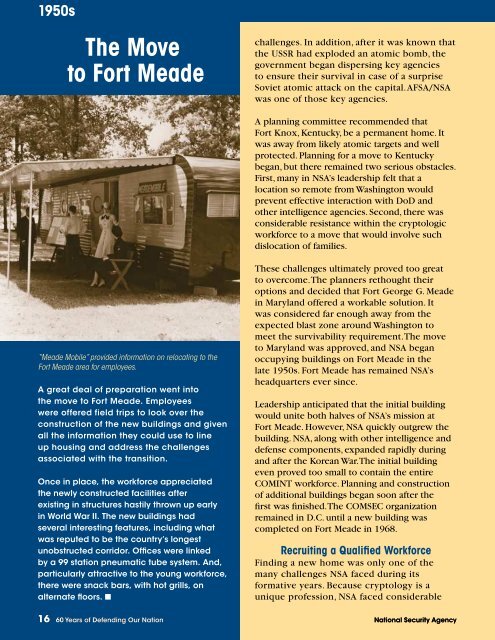National Security Agency - The Black Vault
National Security Agency - The Black Vault
National Security Agency - The Black Vault
- No tags were found...
Create successful ePaper yourself
Turn your PDF publications into a flip-book with our unique Google optimized e-Paper software.
1950s<br />
1950s<br />
<strong>The</strong> Move<br />
to Fort Meade<br />
challenges. In addition, after it was known that<br />
the USSR had exploded an atomic bomb, the<br />
government began dispersing key agencies<br />
to ensure their survival in case of a surprise<br />
Soviet atomic attack on the capital. AFSA/NSA<br />
was one of those key agencies.<br />
“Meade Mobile” provided information on relocating to the<br />
Fort Meade area for employees.<br />
A great deal of preparation went into<br />
the move to Fort Meade. Employees<br />
were offered field trips to look over the<br />
construction of the new buildings and given<br />
all the information they could use to line<br />
up housing and address the challenges<br />
associated with the transition.<br />
Once in place, the workforce appreciated<br />
the newly constructed facilities after<br />
existing in structures hastily thrown up early<br />
in World War II. <strong>The</strong> new buildings had<br />
several interesting features, including what<br />
was reputed to be the country’s longest<br />
unobstructed corridor. Offices were linked<br />
by a 99 station pneumatic tube system. And,<br />
particularly attractive to the young workforce,<br />
there were snack bars, with hot grills, on<br />
alternate floors. n<br />
A planning committee recommended that<br />
Fort Knox, Kentucky, be a permanent home. It<br />
was away from likely atomic targets and well<br />
protected. Planning for a move to Kentucky<br />
began, but there remained two serious obstacles.<br />
First, many in NSA’s leadership felt that a<br />
location so remote from Washington would<br />
prevent effective interaction with DoD and<br />
other intelligence agencies. Second, there was<br />
considerable resistance within the cryptologic<br />
workforce to a move that would involve such<br />
dislocation of families.<br />
<strong>The</strong>se challenges ultimately proved too great<br />
to overcome. <strong>The</strong> planners rethought their<br />
options and decided that Fort George G. Meade<br />
in Maryland offered a workable solution. It<br />
was considered far enough away from the<br />
expected blast zone around Washington to<br />
meet the survivability requirement. <strong>The</strong> move<br />
to Maryland was approved, and NSA began<br />
occupying buildings on Fort Meade in the<br />
late 1950s. Fort Meade has remained NSA’s<br />
headquarters ever since.<br />
Leadership anticipated that the initial building<br />
would unite both halves of NSA’s mission at<br />
Fort Meade. However, NSA quickly outgrew the<br />
building. NSA, along with other intelligence and<br />
defense components, expanded rapidly during<br />
and after the Korean War. <strong>The</strong> initial building<br />
even proved too small to contain the entire<br />
COMINT workforce. Planning and construction<br />
of additional buildings began soon after the<br />
first was finished. <strong>The</strong> COMSEC organization<br />
remained in D.C. until a new building was<br />
completed on Fort Meade in 1968.<br />
Recruiting a Qualified Workforce<br />
Finding a new home was only one of the<br />
many challenges NSA faced during its<br />
formative years. Because cryptology is a<br />
unique profession, NSA faced considerable<br />
difficulty in recruiting and retaining<br />
qualified employees for its specialized<br />
workforce. Typically, personnel from the<br />
Service Cryptologic Agencies did not stay<br />
long after converting to civilian status. To<br />
add to the recruitment challenge, none of<br />
NSA’s job descriptions were in the Civil<br />
Service Registry. Throughout the 1950s, NSA<br />
pushed to have recognition as an “excepted<br />
service,” with hiring and firing authority and<br />
the ability to define its own jobs. President<br />
Eisenhower supported this approach.<br />
Eventually, NSA’s hiring and firing authority<br />
was granted through the enactment of Public<br />
Law 86-36, “<strong>National</strong> <strong>Security</strong> Act of 1959.”<br />
A World-Wide Cryptologic System<br />
In the late 1940s and early 1950s, as the<br />
dimensions of the Cold War became apparent,<br />
NSA and the uniformed services moved from<br />
a collection focus on Germany and Japan to<br />
sites better situated for collecting signals<br />
from the USSR, Eastern Europe, China, and<br />
North Korea.<br />
<strong>National</strong> <strong>Security</strong> <strong>Agency</strong>, circa 1950.<br />
Over time, NSA asserted control over location<br />
surveys, a prerequisite to establishing physical<br />
locations for new sites. Consequently, NSA was<br />
able to influence where the Service Cryptologic<br />
Agencies established their field sites.<br />
Eventually, a three-tier COMINT system<br />
emerged worldwide, driven by needs for<br />
COMINT and the communications capacities<br />
of the era. Forward sites collected and<br />
processed any “take” that was time-sensitive<br />
and could be handled without sophisticated<br />
equipment. Intermediate stations, often at<br />
theater level, dealt with material that needed<br />
more processing but still had to be distributed<br />
quickly. Intercept that required processing on<br />
massive computer banks or needed only for<br />
long-term study was sent to NSA. In addition,<br />
the Navy and Air Force operated mobile<br />
collection platforms that fed intercept into the<br />
system at appropriate levels.<br />
To serve worldwide customers, particularly<br />
the major military commands in Europe<br />
16 60 Years of Defending Our Nation <strong>National</strong> <strong>Security</strong> <strong>Agency</strong><br />
<strong>National</strong> <strong>Security</strong> <strong>Agency</strong> 60 Years of Defending Our Nation 17

















